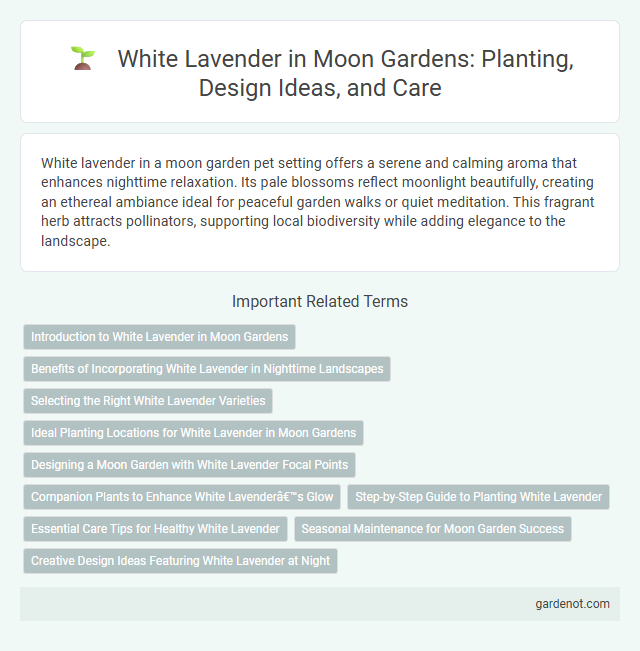White lavender in a moon garden pet setting offers a serene and calming aroma that enhances nighttime relaxation. Its pale blossoms reflect moonlight beautifully, creating an ethereal ambiance ideal for peaceful garden walks or quiet meditation. This fragrant herb attracts pollinators, supporting local biodiversity while adding elegance to the landscape.
Introduction to White Lavender in Moon Gardens
White lavender is a striking addition to moon gardens, known for its luminous, silvery-white blooms that thrive in moonlight. Preferring well-drained soil and full sun to partial shade, this aromatic plant enhances nighttime garden aesthetics with its soft fragrance and pale flowers. Its reflective white petals amplify moonlight, creating a tranquil, ethereal atmosphere ideal for evening relaxation.
Benefits of Incorporating White Lavender in Nighttime Landscapes
White lavender enhances nighttime gardens by emitting a calming fragrance known for reducing stress and promoting relaxation, which supports restful sleep. Its pale blooms reflect moonlight, creating a serene and visually soothing atmosphere ideal for evening enjoyment. Incorporating white lavender improves nighttime pollination by attracting moths and other nocturnal pollinators, fostering biodiversity in garden ecosystems.
Selecting the Right White Lavender Varieties
Selecting the right white lavender varieties for a moon garden involves choosing cultivars such as Lavandula angustifolia 'Alba' and Lavandula intermedia 'Silberschweif' known for their fragrant white blooms and drought tolerance. These varieties thrive in full sun with well-drained soil, enhancing the night-time ambiance with their silvery foliage and subtle scent. Prioritizing disease resistance and bloom duration ensures a lasting visual and aromatic appeal in moon garden designs.
Ideal Planting Locations for White Lavender in Moon Gardens
White lavender thrives in moon gardens when planted in well-drained, sandy or loamy soil with full sun exposure, enhancing its silvery foliage under moonlight. Ideal locations include open borders, rock gardens, and near reflective surfaces like white walls or light-colored pathways to amplify its luminous appearance at night. Positioning white lavender where it can receive at least six hours of direct sunlight daily ensures optimal growth and prolonged blooming, contributing to the serene ambiance of the moon garden.
Designing a Moon Garden with White Lavender Focal Points
White lavender serves as an exquisite focal point in moon garden designs, its silvery foliage and delicate white blooms reflecting moonlight to create a tranquil nighttime ambiance. Planting clusters of white lavender along pathways or around seating areas enhances visual interest and emits a soothing fragrance that complements the serene atmosphere. Combining white lavender with complementary moon garden plants like silver-leaved lamb's ear and white-flowered hostas amplifies the ethereal glow and texture contrast essential for captivating nighttime landscapes.
Companion Plants to Enhance White Lavender’s Glow
White lavender thrives when paired with companion plants like rosemary, sage, and catmint, which complement its silvery foliage and amplify its calming fragrance. Gardeners often plant white lavender alongside ornamental grasses and pale blooms such as white roses or silver-leaved artemisia to create a mesmerizing, moonlit garden effect. These companion plants not only enhance white lavender's glow but also support pollinators and improve overall garden health.
Step-by-Step Guide to Planting White Lavender
Choose a sunny location with well-draining soil to plant white lavender, ensuring it receives at least 6 hours of sunlight daily. Prepare the soil by mixing sand or gravel to improve drainage, then dig holes spaced 12-18 inches apart for proper air circulation. Plant white lavender seedlings at root level, water thoroughly, and mulch with small stones or gravel to maintain moisture and prevent weed growth.
Essential Care Tips for Healthy White Lavender
White lavender thrives in well-drained, sandy soil with full sun exposure, requiring at least 6 to 8 hours of direct sunlight daily for optimal growth. Regular pruning after flowering encourages bushier plants and prolongs blooming periods, while watering deeply but infrequently prevents root rot by allowing the soil to dry between sessions. Applying a balanced, low-nitrogen fertilizer in early spring supports healthy foliage development and maintains the plant's vibrant white blooms throughout the growing season.
Seasonal Maintenance for Moon Garden Success
White lavender thrives with seasonal maintenance tailored to Moon Garden conditions, including pruning after flowering to promote healthy growth and prevent woody stems. Applying a balanced fertilizer in early spring supports robust blooms during the growing season. Ensuring well-drained soil and moderate watering helps maintain plant vigor and enhances the aromatic experience in Moon Garden.
Creative Design Ideas Featuring White Lavender at Night
White lavender in a moon garden creates an ethereal glow that enhances nighttime ambiance with its silvery-white flowers and subtle fragrance. Incorporate white lavender alongside soft LED lighting or solar lanterns to highlight its delicate texture and soothing scent, perfect for tranquil evening retreats. Pairing it with reflective surfaces like white stones or light-colored furniture amplifies its luminescent effect, transforming your garden into a serene sanctuary under the moonlight.
White lavender Infographic

 gardenot.com
gardenot.com